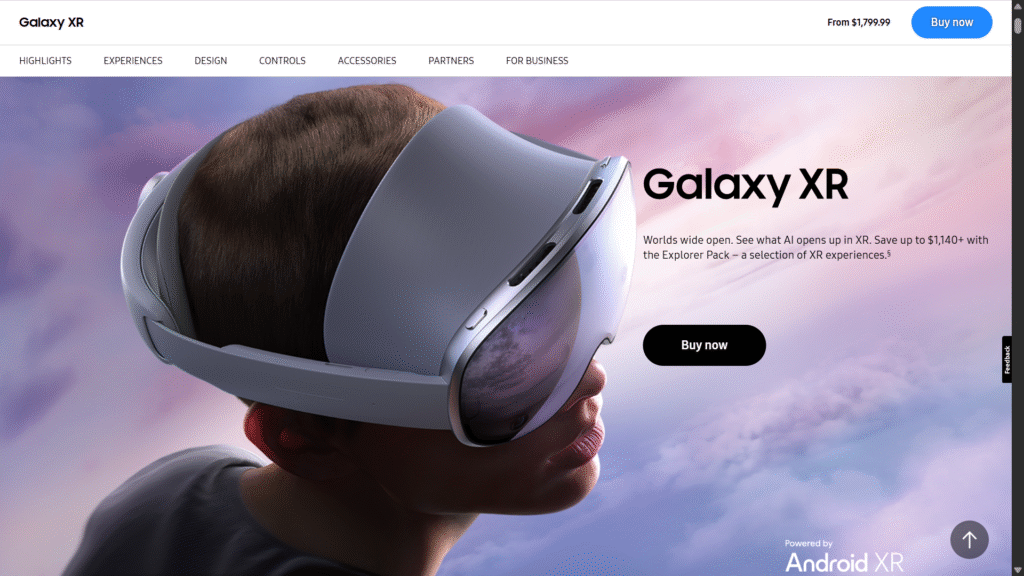
Samsung has officially entered the high-stakes Extended Reality (XR) market with the launch of the Galaxy XR headset. Born from the collaborative might of Samsung, Google, and Qualcomm, the device is positioned as a primary competitor to the Apple Vision Pro, offering a powerful, AI-driven experience at a premium price point that is roughly half the cost of its rival.
The Galaxy XR is the first device to run Android XR, a new operating system built from the ground up by Google to integrate Extended Reality with its advanced AI capabilities.
Definitive Specs and Features: A True Premium Competitor
The Galaxy XR, previously known by its codename Project Moohan, is packed with cutting-edge technology designed to deliver both high-fidelity visuals and a seamless mixed-reality experience.
| Feature | Samsung Galaxy XR Specification | Key Benefit |
| Price | $1,799.99 (US Launch) | Significantly undercuts the $3,499 Apple Vision Pro. |
| Processor | Qualcomm Snapdragon XR2+ Gen 2 | Dedicated, high-performance chip for complex XR and AI tasks. |
| Displays | Dual 4K Micro-OLED (approx. 29 million pixels total) | High-density display for exceptional visual clarity. |
| Operating System | Android XR (First device to run Google’s new OS) | Provides access to a wide ecosystem of optimized Android apps. |
| Core AI | Google Gemini (System-Level Integration) | Enables contextual voice, vision, and gesture interactions within the real and virtual world. |
| Weight | 545g (headset only). External battery pack weighs 302g. | Lighter headset portion designed for better long-term comfort. |
| Controls | Hand Gestures, Eye Tracking, Voice Commands + Support for Optional Physical Controller | Offers flexible control for both casual use and intensive gaming/productivity. |
| Battery Life | Up to 2 hours (General Use) / Up to 2.5 hours (Video Playback), according to Samsung claims. | Standard for premium, high-power XR headsets. |
The Android XR and Gemini AI Advantage
The core differentiator for Samsung is the software ecosystem built through its trilateral partnership with Google and Qualcomm.
1. Android XR: The AI-Centric Ecosystem
The new Android XR platform is designed as an open, scalable operating system.
- App Ecosystem: According to Google, the platform supports existing Android apps, allowing users to run them as scalable, floating 2D windows in their environment, instantly creating a limitless digital workspace. Some apps may require optimization for the best XR experience.
- XR-Optimized Core Apps: Core Google apps like YouTube, Google Maps (with immersive 3D navigation), and Google Photos (3D spatial viewing) have been specially adapted for the XR environment.
2. Gemini AI: Your Contextual Companion
Google’s Gemini AI is integrated directly into the system, designed to act as a context-aware companion:
- Circle to Search (XR Edition): Leveraging the headset’s passthrough cameras, users can look at a real-world object and use a hand gesture to “circle” it, prompting Gemini to perform an instant, contextual search.
- Real-Time Assistance: Gemini can see what the user sees, providing contextual help. For instance, you can ask, “What’s that landmark?” while looking at a virtualized version of the Eiffel Tower to get a real-time answer.
- Simplified Interaction: Users can use natural language to navigate through immersive 3D maps or find content on YouTube.
Availability and Market Position
The Samsung Galaxy XR headset is a bold strategic move by the three tech giants to capture the high-end mixed-reality market.
The headset is available now in the U.S. and South Korea, with global markets expected to follow. Its strategic pricing at $1,799.99 aims to make premium, AI-powered mixed reality more accessible to a broader audience than its main competitor.
Disclaimer: This blog post was generated with the help of artificial intelligence. Readers are encouraged to verify facts independently.


